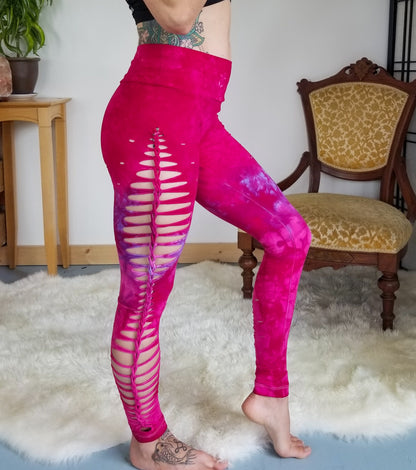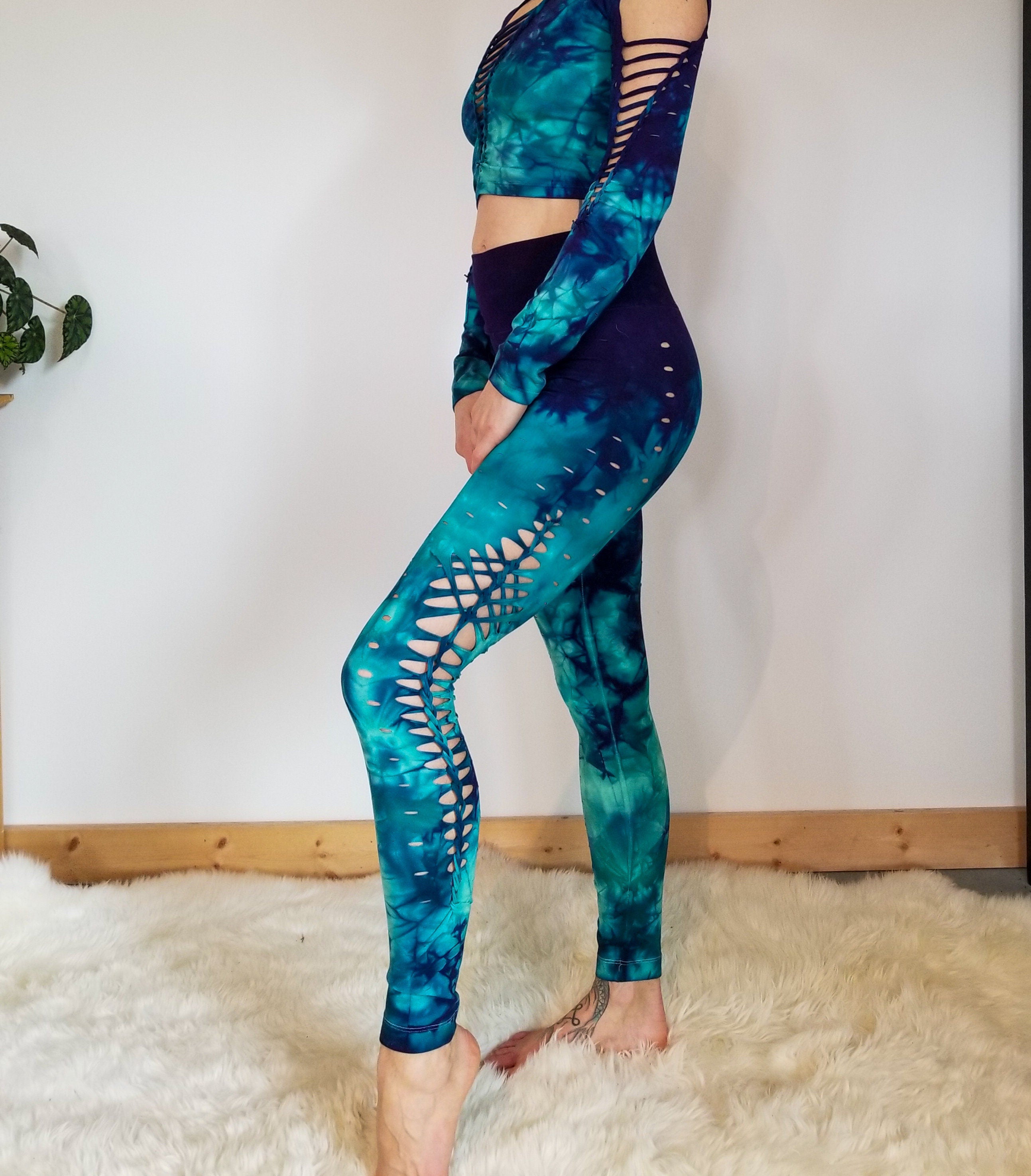
How To Care For Hand-Dyed Clothing: Preserve Vibrant Colors
Share
Hand-dyed clothing is unique and beautiful. The bright colors and special patterns make these clothes stand out. But to keep them looking good, you need to take care of them the right way. Hand-dyed clothes need extra attention because the colors can fade or bleed more easily than regular clothes. Let's learn how to take care of hand-dyed clothing so your favorite pieces stay colorful for a long time. This way, you'll get the most out of these special clothes.
Key Takeaways
| Aspect | Recommendation |
|---|---|
| Washing | Use cold water and gentle, color-safe detergents |
| Drying | Air dry in shade, avoid direct sunlight |
| Storage | Keep in cool, dry place away from sunlight |
| Frequency | Wash only when necessary to preserve colors |
| Fabric-specific care | Adjust care routine based on fabric type |
Understanding Hand-Dyed Fabrics
Hand-dyed clothes are special because each piece is unique. The dyes used are often more sensitive than those in mass-produced garments, as they are typically applied in smaller batches with more artisanal techniques. This means they need extra care to keep their bright colors vibrant over time. When you buy hand-dyed clothing, you're getting something that's one-of-a-kind, with colors and patterns that can't be exactly replicated. But with that uniqueness comes the need for special care to maintain the integrity of the dyes and the fabric.
The dyes used in hand-dyeing can sometimes bleed or fade if not washed properly. This is because the dye might not be as deeply set as in factory-dyed clothes, where industrial processes ensure maximum color fastness. The hand-dyeing process often involves natural or low-impact dyes, which can be more environmentally friendly but may require more delicate handling. Don't worry, though! With the right care, you can keep your hand-dyed clothes looking amazing for a long time. Understanding the nature of these fabrics is the first step in preserving their beauty and extending their lifespan in your wardrobe.
Preparing to Wash Your Hand-Dyed Clothes
Before you start washing, there are a few crucial steps you should take to ensure the best care for your hand-dyed garments:
- Sort your clothes by color. Keep dark colors separate from light ones to prevent any potential color transfer. This is especially important for newly dyed items that may still have some excess dye.
- Turn your clothes inside out. This helps protect the outside of the fabric from friction during washing, which can cause fading and wear. It also exposes the inner side of the fabric, which may have more excess dye, to the washing water.
- Check if the colors might run. You can do this by wetting a small, hidden part of the clothing and pressing it with a white cloth. If color comes off on the cloth, you'll need to be extra careful when washing. Consider washing the item separately or even hand-washing it until the excess dye is removed.
- Pre-treat any stains gently. Use a mild stain remover and test it on an inconspicuous area first to ensure it doesn't affect the dye.
- Consider using a color catcher sheet in the wash. These sheets can absorb loose dye in the water, preventing it from settling on other parts of the garment or other clothes.
These preparatory steps will help prevent color bleeding and keep your hand-dyed tops and other items looking their best for longer. By taking the time to properly prepare your hand-dyed clothes for washing, you're investing in their longevity and preserving their unique beauty.
Choosing the Right Detergent
The detergent you use is super important for hand-dyed clothes. The wrong choice can strip color, cause fading, or even damage the fabric. You want to pick one that's gentle and won't hurt the dyes. Here's what to look for:
- Use a mild detergent without harsh chemicals. Look for products specifically formulated for delicate fabrics or those labeled as "color-safe."
- Look for detergents made for delicate fabrics or hand-dyed clothes. These are often pH-neutral and designed to clean effectively without disturbing dyes.
- Avoid detergents with bleach or brighteners. These can fade the colors and break down the dye molecules, leading to premature wear of your hand-dyed items.
- Natural detergents can be good, but make sure they're pH neutral. Some natural products can be acidic or alkaline, which might affect the dye.
- Consider using specialized wool washes for protein fibers like silk or wool, even if they're hand-dyed. These detergents are formulated to clean and protect these delicate fibers.
- Liquid detergents are often preferable to powders as they dissolve more easily in cold water, which is best for hand-dyed fabrics.
Some people even use special soap made just for hand-dyed fabrics. These are great if you can find them, but a gentle, regular detergent works too. When in doubt, opt for a detergent designed for baby clothes, as these are typically very mild and free from harsh chemicals. Remember, less is often more when it comes to detergent for hand-dyed clothes – using too much can leave residue on the fabric and potentially interact with the dyes over time.
Washing Techniques for Hand-Dyed Clothing
Now, let's talk about how to actually wash your hand-dyed clothes. The washing process is crucial in maintaining the vibrancy and integrity of the dyes:
- Use cold water. Hot water can make the dyes bleed and fade, as well as potentially shrink or damage certain fabrics. Cold water helps preserve both the color and the fabric structure.
- If you're washing by hand, be gentle. Don't scrub hard or wring the clothes. Instead, gently agitate the garment in the water and squeeze out excess water without twisting.
- If using a machine, use the gentlest cycle. This is usually called "delicate" or "hand wash". These cycles use less agitation and are shorter, which is kinder to hand-dyed fabrics.
- Don't wash too often. Only wash when the clothes are actually dirty. Overwashing can lead to faster fading and wear of the fabric.
- Consider using a mesh laundry bag for extra protection in the washing machine. This reduces friction between the garment and other items or the machine itself.
- For very delicate or highly saturated items, hand washing might be the best option. Fill a basin with cold water and gentle detergent, submerge the garment, and gently move it through the water.
- Rinse thoroughly to remove all soap residue, which can dull colors over time if left in the fabric.
Remember, the less you wash your hand-dyed clothes, the longer they'll keep their bright colors. If you're just airing them out, hanging them outside in the shade can freshen them up without a full wash. For items like festival wear that might not get dirty but need refreshing, consider using a fabric spray or steaming to remove odors without washing.
Drying Your Hand-Dyed Clothes
Drying is just as important as washing when it comes to hand-dyed clothes. The drying process can significantly impact the longevity of the colors and the shape of the garment. Here's how to do it right:
- Air dry whenever possible. It's the gentlest way to dry your clothes and helps preserve both the fabric and the dye.
- Hang clothes in the shade. Direct sunlight can fade the colors rapidly, especially for natural dyes. If you must dry outside, choose a shaded area or dry the items inside out.
- If you must use a dryer, use the lowest heat setting. High heat can set in stains, cause shrinkage, and fade colors more quickly.
- For delicate items like festival wear, lay them flat to dry. This helps them keep their shape and prevents stretching, especially important for knit fabrics.
- Use padded or wooden hangers for hanging items to avoid creating shoulder bumps in garments.
- For items prone to stretching, like sweaters or some hand-dyed leggings, lay them flat on a towel and reshape them gently before leaving to dry.
- If using a drying rack, place a towel underneath to catch any drips, especially for deeply saturated items.
Avoid hanging wet, colorful clothes over other items. The dye might drip and stain the clothes below. If you're drying multiple hand-dyed items, give each piece plenty of space to ensure good air circulation, which promotes even drying and helps prevent any lingering dampness that could lead to mildew or odors.
Storing Your Hand-Dyed Clothing
How you store your hand-dyed clothes can affect how long they stay bright and in good condition. Proper storage is crucial for maintaining the quality of your garments between wears. Here are some detailed tips:
- Store clothes in a cool, dry place. Excessive heat or humidity can affect the dyes and potentially encourage mold growth.
- Keep them out of direct sunlight when not wearing them. UV rays can fade colors over time, even through windows.
- Use padded hangers for delicate items to avoid stretching. Wire hangers can create shoulder bumps and potentially snag delicate fabrics.
- Don't pack clothes too tightly in your closet. They need some air to breathe, which helps prevent mustiness and allows any residual dye smells to dissipate.
- Consider using acid-free tissue paper between folded items, especially for deeply colored pieces, to prevent color transfer.
- For long-term storage, clean items thoroughly before putting them away to prevent stains from setting.
- Use breathable garment bags for hanging clothes to protect from dust while still allowing air circulation.
- Cedar blocks or lavender sachets can help keep stored clothes fresh and deter moths without harsh chemicals.
For special items like hand-dyed leggings, consider storing them flat in a drawer instead of hanging. This prevents stretching at the waistband and knees. If you must fold color-saturated items, use a piece of white tissue paper at the folds to prevent color transfer where the fabric touches itself.
Dealing with Different Fabrics
Different fabrics need different care, even when they're hand-dyed. The base material of your garment plays a crucial role in how it should be treated:
- Cotton and linen are usually tougher and can handle more washing. However, they may be more prone to shrinkage, so cold water washing and air drying are still recommended.
- Silk and delicate fabrics might need special care or even dry cleaning. Hand washing in cold water with a specialized silk detergent is often the safest option for silk items.
- For yoga wear, look for care instructions specific to the fabric blend. Many yoga clothes are made from synthetic blends that require special care to maintain their stretch and moisture-wicking properties.
- Wool and other animal fibers should be treated with extra care. Use wool-specific detergents and always dry flat to maintain shape.
- Rayon and bamboo fabrics often require gentle handling as they can be prone to shrinkage and losing shape when wet.
- Synthetic fibers like polyester often hold dye well but can be prone to static and pilling. Use fabric softeners sparingly, if at all, as they can affect the fabric's performance.
Always check the care label on your clothes. Even if they're hand-dyed, the base fabric will affect how you should care for them. When in doubt, opt for the gentlest care method recommended for that fabric type. For blended fabrics, follow the care instructions for the most delicate fiber in the blend.
Fixing Common Problems
Sometimes, even with the best care, you might run into issues with your hand-dyed clothes. Here's how to deal with some common problems:
- Color bleeding: If colors start to run, wash the item alone in cold water until the water runs clear. Adding a cup of white vinegar to the rinse water can help set the dye.
- Fading: Use a color-safe detergent and wash less often to prevent fading. For items that have already faded, consider using a color-restoring product specifically designed for that fabric type.
- Stains: Treat stains quickly, but be gentle. Test any stain remover on a hidden spot first. For organic stains, enzymatic cleaners can be effective without harming the dye.
- Dullness: A vinegar rinse (one part vinegar to four parts water) can help restore shine to hand-dyed fabrics, especially for plant-based fibers.
- Shrinkage: While prevention is key, some slightly shrunk items can be reshaped when damp. Gently stretch the fabric and pin it to a flat surface to dry.
- Pilling: Use a fabric shaver or sweater stone to carefully remove pills without damaging the fabric or affecting the dye.
If you're dealing with a really tricky issue, it might be best to ask the person who dyed the clothes for advice. They often know the best ways to care for their specific dyes and can provide tailored solutions. For valuable or sentimental items, consider consulting a professional cleaner who specializes in hand-dyed or delicate fabrics.
Eco-Friendly Care for Hand-Dyed Clothes
Caring for your hand-dyed clothes can be eco-friendly too! By adopting environmentally conscious practices, you not only preserve your garments but also reduce your ecological footprint. Here are some expanded tips:
- Use natural, biodegradable detergents. Look for plant-based options that are free from phosphates, sulfates, and artificial fragrances.
- Wash full loads to save water and energy. This reduces the number of washes and the resources used per garment.
- Air dry to save electricity and be gentler on your clothes. If possible, set up a clothesline or drying rack in a shaded outdoor area or well-ventilated indoor space.
- Try using a hand-dyed legging multiple times before washing if it's not dirty. Airing out clothes between wears can often freshen them up without the need for a full wash.
- Use cold water for washing, which saves energy and is better for maintaining dye integrity.
- Consider making your own gentle detergent using natural ingredients like soap nuts, which are biodegradable and effective for delicate fabrics.
- Invest in a microfiber-catching laundry bag to prevent synthetic fibers from entering waterways.
- Repurpose old hand-dyed items that are beyond wear as cleaning rags or craft materials to reduce waste.
These steps not only help the environment but also keep your clothes looking great for longer. By adopting these eco-friendly practices, you're contributing to sustainability in fashion while preserving the unique beauty of your hand-dyed garments.
Bringing Life Back to Faded Hand-Dyed Clothes
If your hand-dyed clothes start to look a bit dull, don't worry! There are several ways to bring back some of that vibrancy without resorting to harsh chemicals or re-dyeing:
- Try a color-boosting wash with a special detergent made for bright colors. These products often contain optical brighteners that can enhance the appearance of faded dyes.
- For natural dyes, sometimes a vinegar rinse can help brighten colors. Use one cup of white vinegar in the rinse cycle to help set dyes and remove any soap residue that might be dulling the colors.
- If all else fails, you might be able to re-dye the item. This works best with natural dyes and should be done carefully to avoid damaging the fabric. Consider consulting the original dyer or a professional for best results.
- For protein fibers like silk or wool, a diluted solution of hair conditioner can help restore shine and softness, which can make colors appear more vibrant.
- Try a salt water soak for plant-based fibers like cotton or linen. Dissolve a cup of salt in cold water and soak the garment for an hour before rinsing thoroughly. This can help set dyes and brighten colors.
- For synthetic fibers, a baking soda paste gently rubbed into the fabric before washing can help lift dirt and oils that might be dulling the colors.
Remember, some fading is normal over time. It's part of what makes hand-dyed clothes special and unique. Embrace the evolving nature of these artisanal pieces, as the subtle changes in color can add character and depth to your garment over time.
Conclusion: Embracing the Beauty of Hand-Dyed Clothing
Caring for hand-dyed clothing might seem like a lot of work, but it's worth it to keep these special pieces looking their best. By following these tips, you can enjoy your vibrant hand-dyed festival wear and other colorful items for years to come. The extra attention you give to these garments not only preserves their beauty but also honors the craftsmanship and artistry that went into creating them.
Remember, each hand-dyed piece is unique. The little changes in color over time are part of what makes these clothes special. They tell a story of wear and care, becoming more personal to you with each passing day. With the right care, you can keep them looking beautiful while also being kind to the environment.
Enjoy your colorful, one-of-a-kind hand-dyed clothes, and have fun showing off your vibrant style! These pieces are not just clothing; they're wearable art that expresses your individuality and appreciation for handcrafted beauty. By caring for them properly, you're preserving a piece of artisanal tradition and ensuring that your unique style continues to shine brightly for years to come.







